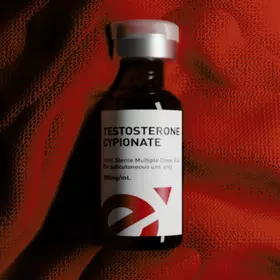Testosterone Replacement Therapy (TRT) is an important treatment for individuals dealing with low testosterone levels, offering benefits like enhanced mood, increased muscle mass, and renewed energy.
However, ensuring testosterone therapy's long-term success and safety requires more than just adjusting dosages; it demands a holistic approach to monitoring that goes beyond the physiological impacts of treatment. Advanced monitoring involves tracking various biomarkers, as they have the potential to provide a clearer picture of how testosterone therapy interacts with the body.
Let's explore the key biomarkers to monitor during testosterone replacement therapy, their significance, what optimal levels look like, and how to adjust your approach based on these metrics.

Key Biomarkers to Track in Advanced Testosterone Replacement Monitoring
If you are on testosterone replacement therapy for low testosterone, identifying which biomarkers are effective for a testosterone replacement therapy monitoring routine can help you effectively manage your serum testosterone levels. Let's look at some key biomarkers, how to monitor them, and practical tips.
1. Testosterone and Free Testosterone
Total testosterone levels are the backbone of testosterone replacement therapy monitoring, offering a snapshot of circulating testosterone in the blood.
However, total testosterone alone doesn't paint the full picture. Free testosterone, representing the hormone fraction unbound by sex hormone-binding globulin (SHBG) or albumin, is the biologically active form that directly interacts with tissues.
Studies suggest that free testosterone levels often correlate more closely with therapeutic outcomes like increased libido, improved energy levels, and muscle growth than total testosterone. Therefore, monitoring both metrics allows for precise dosage adjustments and ensures the testosterone therapy stays within safe and effective boundaries.
What to Track:
- Total Testosterone: Maintain testosterone levels within the reference range of 300-1,000 ng/dL. Individualized targets may vary based on age, symptoms, and overall health.
- Free Testosterone: Aim for 1-2% of total testosterone (typically 5-20 ng/dL). This ensures sufficient hormone availability without falling into excessive testosterone levels that can lead to side effects.
Why It Matters:
- Over-treatment can lead to symptoms like acne, irritability, and even cardiovascular issues.
- Under-treatment may result in suboptimal benefits, leaving you feeling as though the testosterone therapy isn't working effectively.
2. Estradiol (E2)
Testosterone naturally converts into estradiol, a form of estrogen, via the aromatase enzyme. While this conversion is essential for bone health and libido, an imbalance can have undesirable effects.
Too much estradiol may cause gynecomastia (development of male breast tissue), bloating, and emotional swings. Conversely, insufficient estradiol can lead to joint discomfort, decreased sexual function, and osteoporosis risk.
A study found that the change in estradiol level is the strongest predictor not only for variations in BMD and libido but also for shifts in hemoglobin and HDL cholesterol levels. Effective monitoring helps achieve a balance and may involve aromatase inhibitors to manage high levels.
What to Track:
- Estradiol Levels: Optimal levels typically range between 20-40 pg/mL for men with low testosterone who are on testosterone replacement therapy. Anything above or below this range can trigger complications.
Practical Tips:
- If estradiol levels spike, dietary changes can help (e.g., reducing alcohol and processed foods) by influencing aromatase activity.
- Consult with your healthcare provider to adjust aromatase inhibitor doses carefully. Over-suppression can be just as problematic as high estradiol.
3. Hematocrit and Hemoglobin
One of testosterone's effects is stimulating red blood cells production, which can improve anemia but also lead to elevated hematocrit and hemoglobin levels.
While increased red blood cells and blood oxygenation sounds great, too much can thicken the blood, raising the risk of serious conditions like thrombosis, heart attack, or stroke. According to a study, TRT can stimulate erythropoiesis, leading to elevated hematocrit levels and, in some cases, secondary erythrocytosis.
This condition may result in symptoms of hyperviscosity, such as headaches, fatigue, blurred vision, and paresthesias, which can significantly impact patient well-being. In symptomatic patients whose hematocrit exceeds 54%, discontinuation of testosterone and consideration of phlebotomy are advised to mitigate risks.
What to Track:
- Hematocrit: Keep levels below 54% to avoid hyperviscosity issues.
- Hemoglobin: Monitor levels to ensure they don't exceed 17 g/dL.
Practical Tips:
- Stay hydrated, as dehydration can exacerbate hematocrit levels.
- If levels creep up, your provider might suggest donating blood—a simple yet effective way to lower red blood cell count safely.
- To ensure safe administration of TRT, baseline hematocrit levels should be assessed prior to initiating testosterone therapy, with serial measurements recommended at 3, 6, and 12 months
4. Lipid Profile
TRT's impact on lipid metabolism is a double-edged sword. While it can improve overall vitality, it may also alter cholesterol levels.
Some men receiving testosterone therapy experience an increase in LDL (the "bad" cholesterol) and a reduction in HDL (the "good" cholesterol). These shifts can elevate cardiovascular risk over time, especially if left unchecked.
What to Track:
- LDL Cholesterol: Aim to keep levels below 100 mg/dL.
- HDL Cholesterol: Maintain levels above 40 mg/dL for men.
- Triglycerides: Target levels below 150 mg/dL.
Practical Tips:
- Incorporate heart-healthy foods like fatty fish, nuts, and olive oil into your diet.
- Exercise regularly. Cardiovascular activities can counteract negative lipid changes associated with testosterone therapy.
5. SHBG (Sex Hormone-Binding Globulin)
SHBG (Sex Hormone-Binding Globulin) is a glycoprotein produced primarily in the liver that plays a vital role in regulating hormone activity by binding to sex hormones such as testosterone, dihydrotestosterone (DHT), and estradiol.
SHBG plays a pivotal role in regulating free testosterone by binding to it and making it biologically inactive. Too much SHBG can result in low testosterone levels, potentially diminishing TRT's benefits, while too little can cause excessively high free testosterone, increasing the risk of side effects like aggression or hair loss.
What to Track:
- SHBG Levels: Regular measurement helps correlate total and free testosterone levels, ensuring that testosterone therapy has positive effects.
Practical Tips:
- Diet can influence SHBG. Cruciferous vegetables like broccoli and Brussels sprouts can help lower excessively high levels.
- Address any underlying health issues (like hypothyroidism or liver disease) that could impact SHBG production.
6. Prostate-Specific Antigen (PSA)
Prostate-specific antigen (PSA) is a protein produced by both normal and malignant prostate cells, making it a critical biomarker for monitoring prostate health during testosterone therapy. Elevated PSA levels can indicate potential prostate issues, such as benign prostatic hyperplasia (BPH).
What to Track:
- Baseline PSA Levels: Typically, PSA levels should remain below 4.0 ng/mL, but trends over time give more critical information than a single reading.
- Rate of Increase: A rapid rise in PSA over a short period may warrant further investigation, even if levels remain within the "normal" range.
Why It Matters:
- Close monitoring of PSA levels ensures that any signs of prostate complications are detected early, allowing for prompt intervention.
Practical Tips:
- Discuss PSA trends with your healthcare provider rather than focusing solely on one-time measurements.
- Ensure regular digital rectal exams (DRE) in addition to PSA tests for comprehensive prostate monitoring.
- Maintain a balanced diet rich in antioxidants (e.g., tomatoes and green tea) to support overall prostate health.
7. Liver Enzymes
The liver is instrumental in metabolizing testosterone, and TRT can occasionally exert stress on this vital organ.
Elevated liver enzyme levels, such as alanine transaminase (ALT) and aspartate transaminase (AST), can indicate liver inflammation or damage, which requires immediate attention.
What to Track:
- ALT and AST Levels: Normal ranges typically fall between 7-56 U/L for ALT and 10-40 U/L for AST.
- Alkaline Phosphatase (ALP): This is another important enzyme to watch, particularly if you're experiencing fatigue, jaundice, or abdominal discomfort.
Why It Matters:
- Sustained high levels of liver enzymes may suggest that testosterone therapy is causing hepatotoxicity, especially if oral testosterone formulations are being used.
- Liver health is critical for the proper metabolism and excretion of hormones and other metabolic byproducts.
Practical Tips:
- Studies show that opting for transdermal (patches or testosterone gel) or injectable testosterone formulations, which bypass the liver, reduces stress on the organ.
- Regularly include liver-friendly foods like leafy greens, turmeric, and beets in your diet.
- Limit alcohol consumption and avoid hepatotoxic medications or supplements.

8. Bone Density and Vitamin D Levels
Testosterone plays a key role in maintaining bone density by stimulating bone formation and reducing bone resorption.
Low testosterone levels are associated with an increased risk of osteoporosis, while optimal levels via TRT can improve bone health. During testosterone treatment, monitoring bone density and Vitamin D levels ensures that TRT effectively supports skeletal health.
What to Track:
- Bone Mineral Density (BMD): A DEXA scan is the gold standard for assessing bone density.
- Vitamin D Levels: Maintain serum levels between 30-50 ng/mL to optimize calcium absorption and bone health.
Why It Matters:
- Men on testosterone therapy who neglect bone health may be at an increased risk of fractures or bone loss.
- Vitamin D deficiency can impair testosterone synthesis and limit the efficacy of TRT.
Practical Tips:
- Include weight-bearing exercises in your fitness routine to strengthen bones.
- Supplement Vitamin D and calcium if dietary intake is insufficient.
- Regularly screen for osteoporosis if you have risk factors like advanced age or a history of fractures.
9. Insulin Sensitivity and Blood Glucose Levels
Testosterone therapy has been shown to improve insulin sensitivity and glycemic control in men with low testosterone, particularly those with metabolic syndrome or Type 2 diabetes. However, neglecting to monitor these parameters can result in unintended metabolic side effects.
What to Track:
- Fasting Blood Glucose (FBG): Aim for levels under 100 mg/dL.
- Hemoglobin A1c (HbA1c): This provides a 3-month average of blood sugar levels, with a target below 5.7% for non-diabetics.
- HOMA-IR (Homeostatic Model Assessment for Insulin Resistance): It is useful for assessing changes in insulin sensitivity.
Why It Matters:
- Improved insulin sensitivity is one of TRT's benefits, but may lead to unexpected blood sugar fluctuations.
- Tracking metabolic markers ensures TRT contributes to overall health rather than creating new challenges.
Practical Tips:
- Pair TRT with a Mediterranean-style diet rich in whole grains, healthy fats, and lean proteins for optimal metabolic health.
- Incorporate resistance training to improve muscle glucose uptake and insulin sensitivity.
- Consult your healthcare provider about adjustments if significant changes in blood sugar levels occur.
10. Inflammatory Markers
Inflammation is a silent yet critical aspect of overall health that TRT can influence. Chronic inflammation has been linked to cardiovascular diseases, metabolic disorders, and even low testosterone levels.
During testosterone treatment, monitoring inflammatory markers can help assess whether TRT is improving systemic health or exacerbating existing issues.
What to Track:
- C-reactive Protein (CRP): High-sensitivity CRP (hs-CRP) is an excellent marker for systemic inflammation. Optimal levels are below 1 mg/L.
- Interleukin-6 (IL-6) and Tumor Necrosis Factor-alpha (TNF-α): Elevated levels may indicate heightened inflammatory activity.
Why It Matters:
- Inflammation can negatively affect TRT outcomes, potentially contributing to fatigue, joint pain, and cardiovascular risk.
- Addressing inflammation can enhance overall testosterone therapy efficacy and long-term health.
Practical Tips:
- Adopt an anti-inflammatory diet, emphasizing omega-3 fatty acids, berries, and dark leafy greens.
- Manage stress through mindfulness or yoga, as chronic stress can elevate inflammatory markers.
- Avoid smoking and limit exposure to environmental toxins that contribute to inflammation.
11. Dihydrotestosterone (DHT)
Dihydrotestosterone (DHT) is an androgen derived from testosterone through the action of the enzyme 5-alpha reductase.
While DHT plays a critical role in male development and certain physiological processes, excessive dihydrotestosterone levels during TRT can lead to side effects, particularly androgenic ones like hair loss and prostate enlargement.
What to Track:
- DHT Levels: Normal serum DHT levels typically range from 30-85 ng/dL, though the optimal range may vary depending on individual factors and TRT response.
- Symptoms: Pay attention to signs of androgen excess, including scalp hair thinning, increased body or facial hair growth, or acne.
Why It Matters:
- High DHT levels are associated with male pattern baldness (androgenic alopecia) and an increased risk of benign prostatic hyperplasia (BPH).
- Low DHT levels can impair libido and reduce the anabolic effects of testosterone therapy.
Practical Tips:
- If dihydrotestosterone levels are elevated, discuss with your healthcare provider the possibility of using a 5-alpha reductase inhibitor like finasteride or dutasteride. However, these medications should be used cautiously, as they may reduce some of TRT's benefits.
- Incorporate natural inhibitors of 5-alpha reductase, such as green tea and saw palmetto, into your routine under professional guidance.
- Regularly monitor your dihydrotestosterone levels, especially if you experience symptoms associated with high androgen activity or are prone to hair loss.
Conclusion
Advanced monitoring during Testosterone Replacement Therapy (TRT) involves a multi-dimensional approach that goes beyond tracking testosterone levels alone.
From estradiol and SHBG to liver enzymes and inflammatory markers, understanding these metrics ensures a personalized, effective, and safe testosterone therapy experience. With proper attention to these biomarkers, testosterone therapy can provide life-changing benefits without compromising long-term health.
Optimizing your testosterone therapy regimen requires a proactive mindset and collaboration with a knowledgeable healthcare provider. By paying close attention to these biomarkers and making lifestyle adjustments as needed, you can maximize the benefits of TRT while minimizing risks, ensuring a healthier, more vibrant life.

Get TRT Online
Optimize Your Hormones





